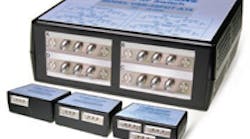Routing RF/microwave signals through a system or test setup can create headaches. But one of the simplest, most-cost-effective "pain relievers" is to reach for one of a series of switch matrices from Mini-Circuits. The firm's new DC-to-18-GHz Smart RF Switch Matrix product family packs from one to four rugged single-pole, double-throw (SPDT) electromechanical switches into a compact housing that can be controlled via Universal Serial Bus (USB) interface.
Mini-Circuits' switch matrices are housed in a compact plastic case measuring 4.26 x 6.08 x 2.25 in. As many as four SPDT electromechanical switches can be mounted in the case (see figure), each with three female SMA connectors for RF/microwave signals. Additional connections include a 2.1-mm socket for DC power and a USB type B port for digital control and data acquisition. The model number convention for these matrices is model USB-1SPDT-A18 for a unit with one SPDT switch, model USB-2SPDT-A18 for a unit with two SPDT switches, and so on.
Each switch matrix is shipped with easy-to-operate graphical-user-interface (GUI) software for control from a PC, as well as an API DLL.com object for users who prefer to develop their own switch software. The GUI software allows as many as 16 switch matrix units to be controlled from a single 32- or 64-b computer running Windows or Linux. The GUI program is compatible with most major test programming languages. The SPDT switch units in a matrix can be selected for independent operation, such as A or B or C or D in a four-switch matrix. They can also be selected for combined operation. Using the four-switch unit as an example, this allows that matrix to be set up as four independent SPDT switches; a pair of single-pole, three-throw (SP3T) switches; one single-pole, four-throw (SP4T) switch and a SPDT switch; and one single-pole, five-throw (SP5T) switch, along with various other configurations.
These are electromechanical RF/microwave switches, usually favored for use in matrices because of their reliability, repeatability, and improved electrical performance. The benefits of these switches over solid-state switches lie not only in the standard electrical parameters, but also in power-handling capability. The SPDT switches are rated for maximum cold-switched power of 10 W and maximum hot-switched power of 1 W.
Insertion loss remains low from DC to 18 GHz, with loss of typically 0.1 dB from DC to 1 GHz, 0.15 dB from 1 to 8 GHz, 0.25 dB from 8 to 12 GHz, and 0.30 dB from 12 to 18 GHz. Isolation is outstanding, with typical performance of 100 dB from DC to 1 GHz, 90 dB from 1 to 8 GHz, 80 dB from 8 to 12 GHz, and 66 dB from 12 to 18 GHz. The VSWR is low and well controlled, typically 1.05:1 from DC to 1 GHz, 1.20:1 from 1 to 12 GHz, and 1.25:1 from 12 to 18 GHz.
The switch matrices operate on a +24-VDC supply, with typically +5 VDC power at the USB port. The current consumption depends upon the number of switches in a matrix, with typically 400 mA at +24 VDC for a matrix with two switches energized and 60 mA for two switches de-energized. The USB port typically draws about 50 mA at +5 VDC in both cases. Mini-Circuits' SPDT switches used in the matrices are rated for typically 10 million switching operations with hot-switched power of 100 mW or less and typically 3 million switching operations with hot-switched power of 1 W. In addition, these switches feature a unique design allowing for easy cleaning.
The switch matrices are shipped with a 2.7-ft. USB cable and a power adapter suitable for US, EU, UK, or IL power systems. Longer USB cables and a mounting bracket are also available.
Mini-Circuits
P.O. Box 350166
Brooklyn, NY 11235-0003
(718) 934-4500
FAX: (718) 443-4661
